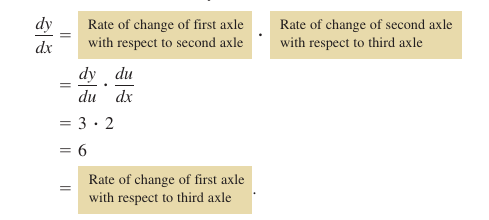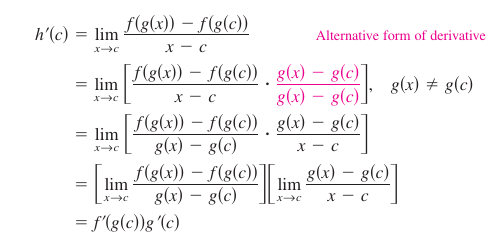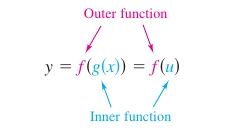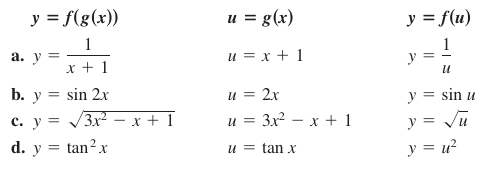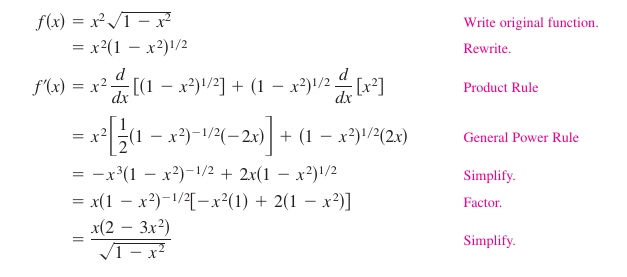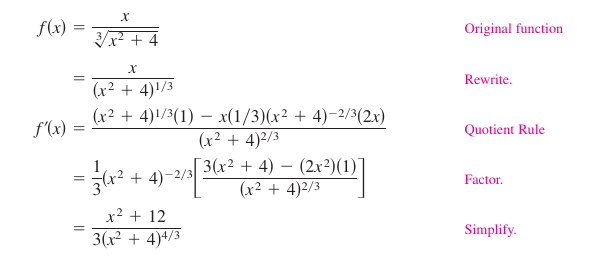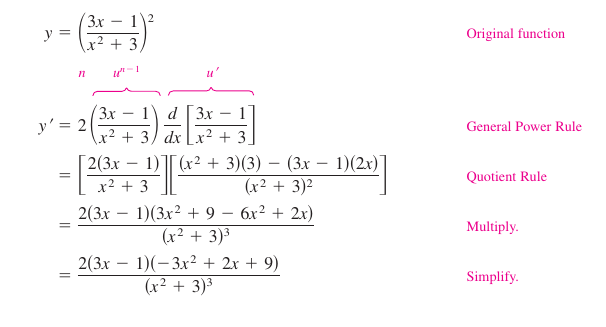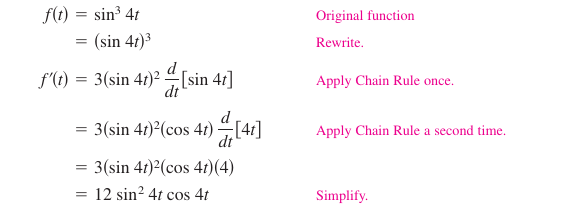Calculus I 02.04 The Chain Rule
| Previous | Calculus_I_02.03_Product_Rule,_Quotient_Rule,_and_Higher-Order_Derivatives |
| Next | Calculus_I_02.05_Implicit_Differentiation |
Contents
- 1 The Chain Rule
- 2 Internal Links
The Chain Rule
- Use the Chain Rule to find the derivative for a composite function.
- Use the General Power Rule to find a derivative.
- Use algebra to simplify a derivative.
- Use the Chain Rule to find the derivative for a trigonometric function.
The Chain Rule finds derivatives for composite functions and adds a surprising versatility to the rules discussed previously. For example, compare the functions shown below. Those on the left can be differentiated without the Chain Rule. Those on the right are differentiated with more ease by using the Chain Rule.
| Without the Chain Rule | With the Chain Rule |
|---|---|
| \(y=x^2+1\) | \(y=\sqrt{x^2+1}\) |
| \(y=\sin x\) | \(y=\sin 6x\) |
| \(y=3x+2\) | \(y=(3x+2)^5\( |
| \(y=x + \tan x\) | \(y=x+ \tan x^2\) |
The Chain Rule stats that if \(y\) changes \(dy/du\) times as fast as \(u\), and \(u\) changes \(du/dx\) times as fast as \(x\), then \(y\) changes \((dy/du)(du/dx)\) times as fast as \(x\).
Example 2.4.1 The Derivative for a Composite Function
|
|
A gear set, as shown in Figure 2.24, is built such that the second and third gears are on the same axle. As the first axle revolves, it drives the second axle, which in turn drives the third axle. Let \(y\), \(u\), and \(x\) represent the revolutions per minute for the first, second, and third axles, respectively. Find \(dy/du\), \(du/dx\), and \(dy/dx\). Show that
Solution Because the second gear's circumference is three times the first, the first axle must make three revolutions to turn the second axle once. The second axle must make two revolutions to turn the third axle once. This can be expressed as
Combine these results to find the first axle must make six revolutions to turn the third axle once. This can be expressed as The change rate for \(y\) with respect to \(x\) is the product between the change for \(y\) with respect to \(u\) and the change rat for \(u\) with respect to \(x\). |
Theorem 2.4.1 The Chain Rule
If \(y=f(u)\) is a differentiable function for \(u\) and \(u=g(x)\) is a differentiable function for \(x\), then \(y=f(g(x))\) is a differentiable function for \(x\) and
- $$\frac{dy}{dx}=\frac{dy}{du}\cdot\frac{du}{dx}$$
or, equivalently,
- $$\frac{d}{dx}[f(g(x))]= {f}'(g(x)){g}'(x).$$
Proof Let \(h(x)=f(g(x))\). Then, using the alternative form show that \(x=c\).
- \({h}'(c)={f}'(g(c)){g}'(c).\)
An important consideration is \(g\)'s behavior as \(x\) approaches \(c\). A problem occurs when there are values for \(x\), other than \(c\), such that
- \(g(x)=g(c).\)
For simplicity assume that \(g(x) \neq g(c)\) for \(x\) values other than \(c\). In proofs for the Product Rule and the Quotient Rule, the same quantity was added and subtracted to obtain the desired form. A similar technique is used here, multiplying and dividing by the same, nonzero, quantity. Note that because \(g\) is differentiable, it is also continuous, and it follows that \(g(x)\) approaches \(g(c)\) as \(x\) approaches \(c\).
When applying the Chain Rule think about the composite function \(f \circ g\) as having two parts, and inner and outer part.
The derivative for \(y=f(u)\) is the derivative for the outer function, at the inner function \(u\) times the derivative for the inner function.
- \({y}'={f}'(u) \cdot {u}'\)
Example 2.4.2 Decomposing a Composite Function
Example 2.4.3 Using the Chain Rule
Find \(dy/dx\) for
- \(y=(x^2+1)^3.\)
Solution Let the inside function be \(u=x^2+1\) and the outer function be \(y=u^3\). Apply the Chain Rule and
- $$\frac{dy}{dx}=\color{red}{\underbrace{\color{black}{3(x^2+1)^2}}_{\color{red}{\frac{dy}{du}}}}\color{red}{\underbrace{\color{black}{(2x)}}_{\color{red}{\frac{du}{dx}}}}=6x(x^2+1)^2.$$
The General Power Rule
Example 2.4.3 used a common composite function, \(y=[u(x)]^n\). The rule for differentiating such functions is called General Power Rule. It is a special case for the Chain Rule.
Theorem 2.4.2 The General Power Rule
If \(y=[u(x)]^n\), where \(u\) is a differentiable function for \(x\) and \(n\) is a rational number, then
- $$\frac{dy}{dx}=n[u(x)]^{n-1}\frac{du}{dx}$$
or, equivalently,
- $$\frac{d}{dx}[u^n]=nu^{n-1}{u}'$$.
Proof Because \(y=[u(x)]^n=u^n\), apply the Chain Rule to obtain
|
$$=\left ( \frac{dy}{du} \right ) \left ( \frac{du}{dx} \right )$$ |
|
$$=\frac{d}{du}[u^n]\frac{du}{dx}.$$ |
Applying The Simple Power Rule produces \(D_u[u^n]=nu^{n-1}\), and it follows that
- $$\frac{dy}{dx}=nu^{n-1}\frac{du}{dx}.$$
Example 2.4.4 Applying the General Power Rule
Find the derivative for \(f(x)=(3x-2x^2)^3.\)
Solution Let \(u=3x-2x^2\). Then
- \(f(x)=(3x-2x^2)^3= u^3.\)
Apply the General Power Rule produces the derivative
Example 2.4.5 Differentiating Functions Involving Radicals
|
|
Find all points on the graph for
for which \({f}'(x)=0\) and those for which \({f}'(x)\) does not exist.
Apply the General Power Rule with \(u=x^2-1\) produces
Therefore, \({f}'(x)=0\) when \(x=0\), and \({f}'(x)\) does not exist when \(x = \pm 1\), as shown in Figure 2.4.2. |
Example 2.4.6 Differentiating Quotients with Constant Numerators
Differentiate the function
- $$g(t)=\frac{7}{(2t-3)^2}.$$
Solution Begin by rewriting the function as
- \(g(t)=-7(2t-3)^{-2}.\)
Apply the General Power Rule with \(u=2t-3\) produces
|
$$=\color{red}{\underbrace{\color{black}{(-7)}}_{\color{red}{\text{Constant}\\ \text{Multiple}\\\text{ Rule}}}}\color{red}{\overbrace{\color{black}{(-2)}}^{\color{red}{n}}}\color{red}{\overbrace{\color{black}{(2t-3)}}^{\color{red}{ u^{n-1} }}}\color{red}{\overbrace{\color{black}{(2)}}^{\color{red}{ {u}' }}} $$ |
Apply General Power Rule |
| \(28(2t-3)^{-3}\) | Simplify | |
|
$$=\frac{28}{(2t-3)^3}.$$ |
Write with positive exponent |
Simplifying Derivatives
Examples 2.4.7, 2.4.8, and 2.4.9 demonstrate techniques for simplifying functions with products, quotients, and composites.
Example 2.4.7 Simplifying by Factoring Out the Least Powers
Find the derivative for \(f(x)=x^2 \sqrt{1-x^2}.\)
Solution
Example 2.4.8 Simplifying the Derivative for a Quotient
Example 2.4.9 Simplifying the Derivative for a Power
Trigonometric Functions and the Chain Rule
The trigonometric functions below are expressed according to the Chain Rule
|
|
|
|
|
|
Example 2.4.10 The Chain Rule and Trigonometric Functions
Example 2.4.11 Parentheses and Trigonometric Functions
To differentiate a function with the form \(k(x)=f(g(h(x)))\), apply the Chain Rule twice, as shown in Example 2.4.12.
Example 2.4.12 Applying the Chain Rule Repeatedly
Example 2.4.13 Tangent Line for a Trigonometric Function
|
|
Find an equation for the tangent line to the graph for (f(x)=2 \sin x + \cos 2x\)at the point \((\pi,1)\), as shown in Figure 2.4.3. Then determine all values for \(x\) on the interval \((0,2 \pi)\) at which the graph for \(f\) has a horizontal tangent.
Conclude that \({f}'(x)=0\) when \(x=\frac{\pi}{6},\frac{\pi}{2},\frac{5\pi}{6},\text{ and }\frac{3\pi}{2}.\) Then \(f\) has horizontal tangents at \(x=\frac{\pi}{6},\frac{\pi}{2},\:\frac{5\pi}{6}, \text{ and }\frac{3\pi}{2}.\) | ||||||||||||||||||||||||||||||
Internal Links
Parent Article: Calculus I 02 Differentiation

